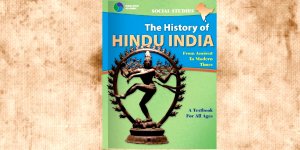| Titi Tudorancea TV / Documentaries |
The History of Hindu India, Part 2/5
History, Documentary
(Tapescript) Namaste! and welcome to India. My name is Raj Narayan. Today we're going to learn about this great country its people and its religious developments during the seven centuries of 300 to 1000 ce.
We will discover India's regional kingdoms, imperial political unification, and great centers of learning and religious development. We will also explore the life in her cities villages and homes, and witness a devotional movement that profoundly influenced Hinduism. During this time, India's Kings built many magnificent monuments and great temples.
I visited the Kailasanatha temple at Ellora in Maharashtra. This temple was carved out of a single solid stone hillside using only hammers and chisels and not by stacking stones together.
The work was begun in the eighth century and took a hundred years to complete. 400,000 tons of stone were removed to create the many chambers standing 266 feet high, it is the largest monolithic sculpture in the world.
The two stairways leading to the main hall of the temple our car with narrative episode of The Hindu epics Mahabharata and Ramayana. This is a temple to Siva but it also has shrines to Vishnu.
Many Buddhist and Jain cave temples are carved into nearby cliffs at Ellora. Ajanta, which is about 75 kilometers away, also has many large Buddhist cave temples. All these were supported by the Hindu kings.
These are just some of the magnificent monuments built in at time when empires, religion, commerce, science, technology literature, and the arts flourished across the subcontinent.
Political History
In three hundred ce, an estimated 75 million people -- a third of the world's population -- lived in India. Hindu tradition, culture, scriptures and the Sanskrit language linked people across this immense and fertile subcontinent.
Historians rely on four major types of evidence: archaeological studies, official inscriptions on stone or metal, coins and contemporary texts including stories, poems, plays and the account of foreign visitors.
The greatest empire of the time was founded in the fourth century CE by Chandra Gupta the first. His son Samudragupta, extended the empire across India and rivaled the Mauryas in dominance over the region after a gap of seven hundred years.
His grandson, Chandra Gupta the Second, famously known as Vikramaditya, is considered the most brilliant king in India's entire history. Through his conquest and well-organized government, he forged political unity and peace across his vast empire.
Historian A.L. Basham called it, "the happiest and most civilized region of the world at the time."
What we regard as Indian culture today developed largely during the time of the Guptas. Ruling from their capital city of Pataliputra, the kings granted local and regional autonomy to the states under their control. Those far from the capital, such as in southern India, paid tribute but were nearly independent.
The empire was responsible for security, major roads, irrigation projects, common welfare and gave exceptional support to learning and the arts.
Gupta culture and economy influenced much of Eurasia notably China and Southeast Asia.
The Gupta Empire declined in the late 5th century because of internal conflict and invasions by Central Asian Hunas -- or Huns -- who had conquered Indian territory east of the Indus to central India early in the 6th century CE. However by the mid-6th century, Hindu rulers united and drove the Hunas out of India.
India received many foreign visitors during this time. The most important were the Buddhist monks, Faxian and Xuanzang, who left us fascinating reports.
Faxian came to India by the Silk Road from China in the fifth century, stayed in India for thirteen years, wrote an account of his visit and returned by sea.
He reported, "Charitable institutions are numerous and rest houses for travelers are provided on the highway. In the cities and towns of this country the people are rich and prosperous and seemed to emulate each other in the practice of virtue.
Another monk and chronicler, Xuanzang left China in 629 for India and returned after 16 years. He has left us the most complete account of the Indian subcontinent of his time. Xuanzang describes a complex political environment with more than 70 regional powers. Many were part of the empire of King Harsha while others were under the major imperial powers of the South. Xuanzang was a guest of Harsha's court for about a year and praised his patronage of Buddhism, just rule and generosity.
In the eighth century the Rashtrakuta dynasty took control of the entire Deccan region, parts of west central India and much of the south. The Rashtrakuta Dynasty also built the Kailasanatha Temple in Ellora. Between the 8th and 10th centuries they competed with the Pratiharas and Palas for dominance over the subcontinent.
The Pratiharas at their peak ruled much of the north. They were the first effectively stop the Arab Muslim invasions into western India in the eighth century. They exacted tribute from the Arab rulers of Sindh and Multan and blocked any further advancement for over 200 years.
The Palas, a Buddhist dynasty centered in eastern India, reached their zenith in the early 9th century until the Pratisharas largely displaced them from the Ganga Plains.
There were several large Hindu kingdoms in the Deccan and southern India in this period. They included the Chalukyas, Pallavas, Pandhyas and Cholas.
Rajendra Chola the first unified the entire south. The Cholas boasted a large army and navy and their maritime expeditions are unique in Indian history. To protect vital trade routes, they subdued kingdoms as far away as Malaysia and Indonesia. The Cholas also dominated southern India's trade between the Middle East, Europe, Southeast Asia, Africa and China.
Indian traders facilitated the spread of Hinduism and Buddhism throughout the kingdoms of Southeast Asia. For example, this is the great Chola temple at Thanjavur in South India and this is the grand Prambanan temple in Central Java, built in the eighth century by the Hindu king Pikatan in Indian style, and this is Angkor Wat in Cambodia, largest religious building in the world.
India's rulers also welcomed Christians, Jews, Muslims, and Parsis into their kingdoms and encouraged them to settle and practice their faiths. This policy maintained religious harmony in society and not surprisingly aided international trade.
For over a thousand years, India was the richest region on earth. It produced thirty percent of the world's total food, goods and services, while China produced 25 percent and Europe -- even by 1000 ce -- produced just eleven percent.
City and village life
Cities and towns group as centers of commerce along important trade routes, at sea and inland river ports and around major temples and pilgrimage centers.
Cities were largely self-governing. A ruling council consists of a chief records clerk and representatives from large businesses, smaller merchants, and guilds of artisans.
An ancient Tamil epic poem called, "The Ankle Bracelet," describes life in a city of that time: Shops selling similar products were located near each other as they still are in many cities of India today. The poet wrote, "In the street, hawkers were selling ointments, bath powders, flowers, perfume and incense. Weavers brought their fine silks and all kinds of fabrics made of wool or cotton. There were special streets for merchants of sandalwood, jewelry, faultless pearls, pure gold and precious gems. One can see coppersmiths, carpenters, goldsmiths, tailors, shoemakers and clever craftsmen making toys out of cork or rags, and expert musicians who demonstrated their mastery of the seven tone scale on the flute and the vena."
Only ten percent of the population lived in cities like this. The rest lived in villages surrounded by agricultural land, as two-thirds still do in India today.
Each village had a pond or reservoir, wells, grazing grounds and at least one temple.
India's year-round warm climate and monsoon rains allowed farmers to grow to crops a year or more.
The villagers were self-sufficient. People bartered and sold their goods in local markets and in nearby towns.
Because the village jatis, or castes, were hereditary, the families became expert in their work, be they farmers, craftsmen or merchants. Each family interacted with the other jatis. There will be a family barber, washerman, carpenter, blacksmith, and others, providing their services to a family generation after generation.
Each village was self governed by an assembly of five elder men called the panchayat. The central unit of the society was the joint family, as it is today among many Hindus. Father, mother, sons and their wives, unmarried daughters and grandchildren all lived under one roof. Land and finances were held in common and everyone worked for the advancement of the family.
Marriages were ideally arranged by the parents and the boy and girl had little say in the matter. But however the union occurred -- such as elopement -- the marriage itself was recognized.
In an arranged marriage, the boy and girl usually came from different villages. Visits to relatives created a strong communications network through which news, ideas, trade and technological innovations flowed freely.
A Classical Age of Culture and Religion
During this time India give rise to a vast wealth of literature, including plays, poems, songs and epics in many languages.
The world's first universities were flourishing in India during this time including Takshashila, Nalanda, Vikramashila and Vallabhi. Students studied the Vedas and 18 Arts and Sciences which included medicine, surgery, astronomy, mathematics, agriculture, accounting, law and military strategy.
Xuanzang stayed at Nalanda University for five years around 640 ce. He described it as a free residential center of advanced studies, notably Buddhist, with 1,000 teachers and 10,000 students. Nalanda was supported by royal endowments from both Hindu and Buddhist Kings as well as regular income from nearly 100 villages.
Many Hindu saints of this time preached the importance of devotion to God and what is called the Bhakti Movement. Bhakti means devotion or worship. The saints stressed one's personal relationship with the divine as a love-centered path of spiritual advancement.
All over India great Hindu temples were built or expanded between 300 and 1000 ce. Many are in large cities such as Somnath in the west, Ujjain in central India, Varanasi on the river Ganga in the north, Puri in the east and Kanchi and Madurai in the south. Today these remain powerful places of worship Life in cities and villages centered around the temples, which were places of worship, scholarship, education, and the performing arts.
During festivals, thousands of people pilgrimage to the most famous temples as they do to this day. This flow of visitors helped local economies and spread cultural practices and religious belief throughout the nation.
The period from 300 to 1000 ce was a golden age in India. The Sanskrit language with its many treasures on religion, philosophy, law and the epics spread throughout not only India but most of Asia.
Hinduism thrived throughout this period with the Bhakti Movement in particular popularizing devotional worship across the subcontinent through sacred stories and songs especially those of the Tamil Alvars and Nayanmars. India's prosperity, stability and religious harmony gave rise to philosophical, technological scientific, literary and artistic achievements that set high standards for succeeding generations. Unfortunately there were those on her northwestern frontier who coveted in India's wealth and land and were driven by a desire to expand their faith and obtain glory.
In part 3 we will tell the sad tale of how India suffered first from periodic raids of royal cities and rich temples for plunder followed by the sustained conquest of large regions in pursuit of political power and religious dominance.
Namaste

Subscribe now to get unrestricted access to all resources, in all languages, throughout this web site!
Subscription Form
YOU MAY ALSO LIKE





Subscribe now to get unrestricted access to all resources, in all languages, throughout this web site!
Subscription Form
